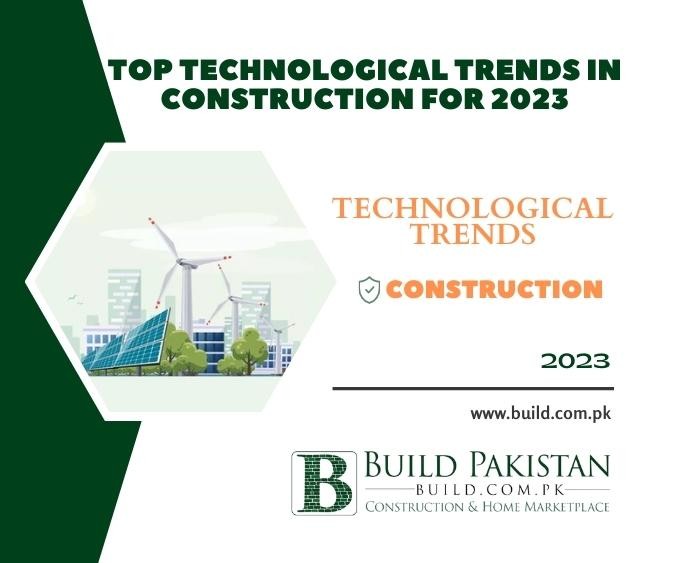Top Technological Trends in Construction for 2023

Introduction:
Technology is not only enhancing our healthcare and education
systems, but it is also significantly changing the construction sector. A
rising number of the most popular building techniques are being made more
efficient and cost-effective by using software, modern technology, and smart
devices.
In this blog, we'll discuss the most recent technological
developments in the building sector that are assisting us in adopting the most
carefully considered and calculated engineering and construction solutions to
make the most use of the resources at our disposal.

TOP TECHNOLOGY TRENDS IN CONSTRUCTION INDUSTRY: A LOOK TO THE FUTURE
These are some notable technical advancements that are
driving the construction sector towards safer, more effective, and
result-oriented procedures.
IMPROVED REALITY:
A more sophisticated version of virtual reality is called
augmented reality (AR) (VR). The goal of augmented reality (AR) is to create a
digital representation of the physical world, where some objects and activities
are enhanced with artificially created sensory input. The use of augmented reality
to capture images of actual project sites and transmit important project
information is beginning in the construction sector.
This enables developers or builders to provide consumers more colourful and immersive descriptions of their projects. Additionally, walkthroughs of structures are also made using augmented reality. To give them a sense of what the finished project will look like, the complete project may be visually superimposed on the project site. This makes it easier for customers to picture the project. Throughout the building process, builders may also employ this technology. From the design phase to the construction phase, inspection, maintenance, and any remodelling chores, AR can play a crucial role at every touchpoint.

THE RISE OF THE DIGITAL TWIN
There are no actual limitations to technology. You'd be
amazed to learn how artificial intelligence (AI) is now being used with
augmented reality (AR) to create digital twins (visual or digital replicas of
real-life objects). Indeed, the method of using digital twins has proven to be
a significant advancement for the building business.
These virtual creations are becoming more and more well-liked
in the world of engineering and design due to their numerous benefits. The
advantages of utilising AI-driven digital twins go beyond the realm of
construction; in fact, the technology may be applied to make a structure or an
entire infrastructure project ecologically friendly.
Digital twins are built on the seamless fusion of technology
connections and automation, all of which are powered by the Internet of Things
(IoT). The actual building's many sensors, gauges, and utility metres are
connected to its digital duplicate.

MODELING INFORMATION BUILDING
The construction sector is embracing some of the most cutting-edge
technological advances today, including business information modelling (BIM).
Building models enable architects to evaluate the long-term durability of the
project's construction materials. A contractor or builder may also envision the
project and, in doing so, estimate the amount of building materials needed to
finish the job. This will make it easier to estimate construction expenses and
the quantity of building materials required for the project.
The capacity to visualise a project using business
information modelling reduces the amount of time needed to establish a
structure, labour costs, and construction costs, as well as the price and
quantity of building supplies.

THE IDEA OF PREFAB HOUSES AND 3D PRINTERS
It appears that the future has already here when considering
the exceptional advantages and features of employing a 3D printer in the field
of building. As the name implies, 3D printers perform quite similarly to
standard printers. This machine has a robotic arm that can manufacture anything
with a three-dimensional shape rather than printing on paper. It is undoubtedly
a cutting-edge technology that makes construction quicker and more accurate,
resulting in lower manufacturing costs and less material waste.
Several portions and components of prefabricated homes, often
known as "modular homes" or "prefab homes," are built in a
factory.

SPIRITUAL CONCRETE
This may seem like yet another fantastical notion from a
science fiction book, yet it is true. There are several applications for this
kind of concrete. A recent technical advancement that might completely change
building upkeep is self-healing concrete. Simple cracks may disappear on their
own by employing self-healing concrete. It is a product that incorporates
bacteria that produces self-active limestone into the construction material.
When activated, the bacteria will repair gaps in walls, roads, and
buildings—pretty much anyplace this self-healing concrete is applied.
This will lessen our reliance on the production of new
concrete, which will slash maintenance costs and lower our carbon impact.

DESIGNS THAT ARE GREEN AND ENERGY EFFICIENT
All of the major players in the construction business are
starting to adopt the trend of developing environmentally friendly and
sustainably constructed complexes. Individuals are reshaping the urban
infrastructure around them using environmentally beneficial methods. These
building techniques place a strong focus on environmentally friendly and green
practises, which include conserving resources whether remodelling or starting
from scratch.
There are several environmentally friendly construction
techniques that are now standard practise, from saving water with the aid of
dual-flush toilets to putting cutting-edge louvre systems and insulating
materials on the exterior of a building to naturally manage temperatures. The
energy-efficient strategy in the building industry is concentrated on
cost-saving and carbon footprint reduction to protect the environment.

TECHNOLOGY OF DRONES
One of the most beneficial innovations in the contemporary era has proven to be drones. Drones offer a wide range of practical uses that make them useful in practically all spheres of life, including aerial photography, real-time surveillance of specific locations, and disaster response activities.










